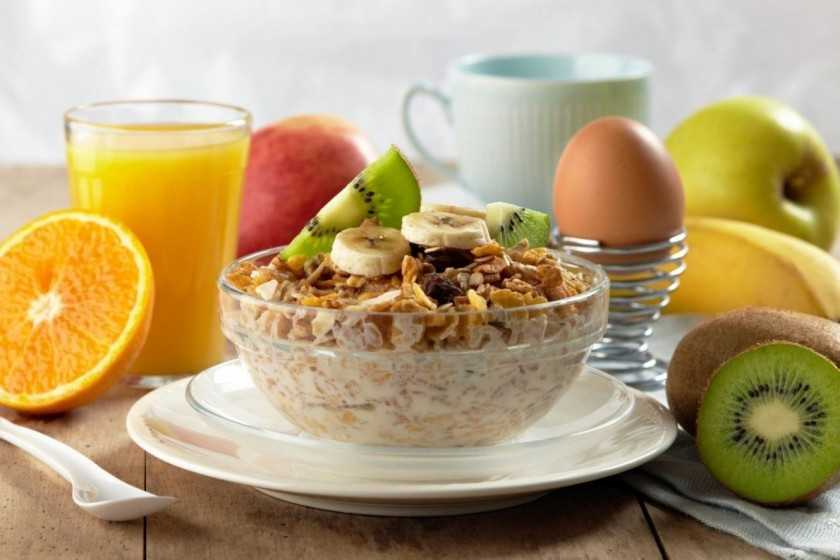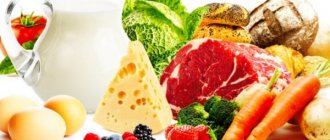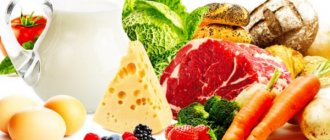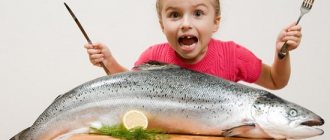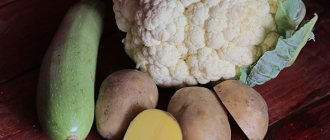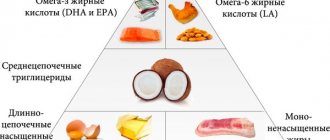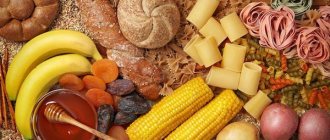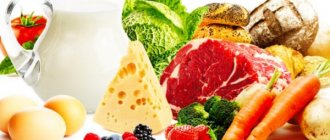What are carbohydrates?
Carbohydrates are organic substances that are the main source of energy for your body. It is one of the three macronutrients you need to survive. The other two are proteins and fats .
Types of carbohydrates:
- Monosaccharides are the simplest carbohydrates that do not break down into even simpler ones. For example, glucose, fructose.
- Oligosaccharides are more complex compounds, built from several (up to 10) monosaccharide residues. For example, beet raffinose.
- Disaccharides are complex compounds built from 2 monosaccharide residues. For example, beet or cane sugar, lactose (milk sugar).
- Polysaccharides are complex compounds formed from a large number of glucose residues. They are divided into digestible (starch) and non-digestible (fiber). Fiber, due to its properties, has a beneficial effect on the entire body as a whole. Helps prevent many diseases, including cancer.
Classification of carbohydrates
Carbohydrates exist in several forms: monosaccharides, oligosaccharides (including disaccharides) and polysaccharides.
Carbohydrates monosaccharides
The simplest carbohydrates are monosaccharides (Greek μόνος “single”, Latin saccharum “sugar”), or simple sugars. Can contain as many as 3 carbon atoms, but those that play a role in energy storage contain 6 carbon atoms: C6H12O6 or (CH2O)6.
Structure of monosaccharides.
Properties of monosaccharides:
- colorlessness;
- hardness of the crystal lattice;
- good solubility in water;
- ability to crystallize;
- sweet taste,
- representation in the form of α and β isomers.
Based on the number of carbon atoms in the molecules, monosaccharides are divided into several groups:
- triose (C3),
- tetrose (C4),
- pentose (C5),
- hexoses (C6),
- heptose (C7).
The most important of them are pentoses and hexoses.
erythrose is an important one - one of the intermediate products of plant photosynthesis.
Pentoses (five-carbon sugars) are widespread in the living world. This group of carbohydrates includes such important substances as ribose (C5H10O4) and deoxyribose (C5H10O5) - sugars that are part of nucleotides - monomers of nucleic acids (DNA and RNA). Deoxyribose differs from ribose in that the second carbon atom has a hydrogen atom rather than a hydroxyl group.
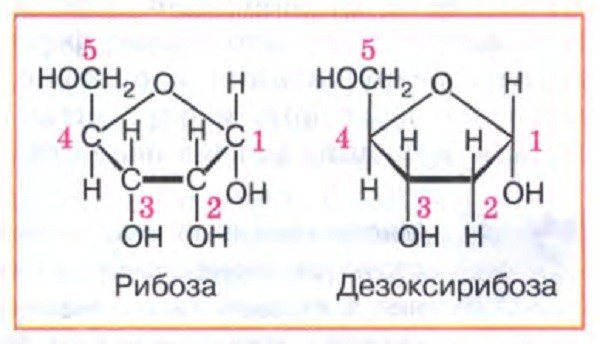
The most common hexoses are glucose, fructose and galactose. These are stereoisomers with the general formula C6H12O6.
Glucose is grape sugar, found in a free state in both plants and animals. Depending on the orientation of the carbonyl group (C=O) when the ring is closed, glucose can exist in two different forms: alpha (α) and beta (β). In α-glucose, the hydroxyl group is located below the plane of the ring at the first carbon atom, and in β-glucose above the plane. Glucose is:
- the most important source of energy for all types of work in the cell;
- monomer of many oligo- and polysaccharides;
- an essential component of blood. A decrease in its concentration leads to disruption of the functioning of nerve and muscle cells, which can be accompanied by convulsions and fainting. Blood glucose levels are regulated by the neurohumoral system;
- an integral part of almost all tissues and organs, where it regulates osmotic pressure;
- liver assistant in performing a barrier role against toxins.
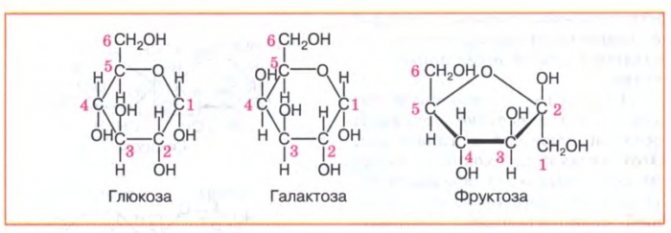
Fructose is also very common in nature. Differs from glucose in the position of the carbonyl carbon (C=O). Serves as a monomer of oligosaccharides. Most of it is found in fruits, which is why it is also called fruit sugar. There is a lot of fructose in sugar beets and honey.
The path of its breakdown in the body is shorter, which is of great importance in the nutrition of patients with diabetes mellitus, when glucose is poorly absorbed by cells.
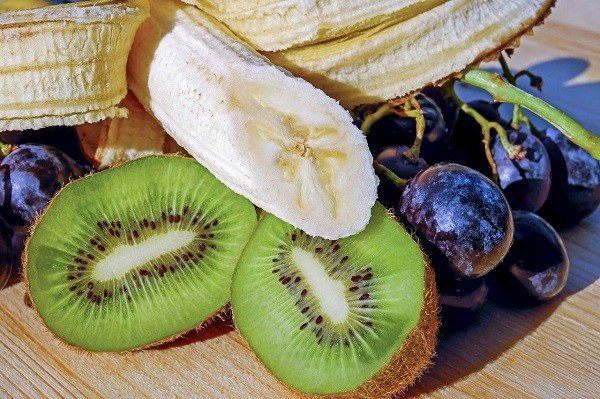
Honey, despite many recommendations to use it instead of sugar, is not an ideal source of carbohydrates. It contains pure sugar.
Honey is formed by the enzymatic hydrolysis of flower nectar in the bee's digestive tract and contains approximately equal amounts of free glucose, fructose and the disaccharide sucrose.

Sugar, which is beneficial, is found in young vegetables, berries, and fruits. Sugar harmful to nutrition - buns, cakes, pastries, cookies, sweet soda, ice cream. Ideally, you can eat 50 g of sweets per day during lunch or as an afternoon snack as a dessert.
Galactose is a spatial isomer of glucose, differing only in the location of the hydroxyl group and hydrogen near the fourth carbon atom. Found in animals, plants and some microorganisms. It is part of lactose - milk sugar, as well as some polysaccharides, such as lactulose. In the liver and other organs, galactose is converted into glucose.
Differences in the structure of these isomers affect their functions. They can be distinguished by taste: fructose, for example, is much sweeter than glucose. The structure of their ring or chain determines their ability to be part of any polymer.
Carbohydrates oligosaccharides
Oligosaccharides (from the Greek ὀλίγος - few) are carbohydrates formed as a result of a condensation reaction between several (from two to 10) monosaccharide molecules. Depending on the number of molecules of monosaccharides, they are distinguished: disaccharides, trisaccharides, tetrasaccharides, etc. The most common among them are disaccharides. Properties of oligosaccharides:
- dissolve in water;
- are slightly soluble in lower alcohols;
- almost insoluble in other common solvents;
- white or colorless;
- crystallize, but not all, some exist in the form of non-crystalline syrups;
- their sweet taste decreases as the number of monosaccharide residues increases.
The bond formed between two monosaccharides is called glycosidic (a type of covalent bond, condensation reaction).
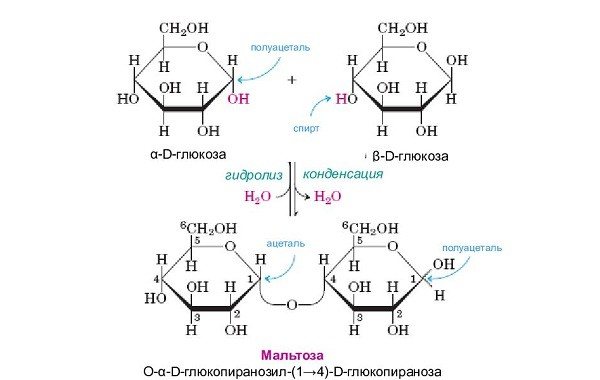
Formation of glycosidic bonds
Carbohydrates disaccharides
In plants and many other organisms, monosaccharides are transformed into disaccharides, a transport form designed for ease of movement within the body. In this form, it is more difficult to split and can be delivered to the right places.
Disaccharides are formed by linking two monosaccharides (ancient Greek δuο - two and σaκχαρον - sugar) with a glycosidic bond. Enzymes that can break this bond are present, as a rule, only in tissues that use glucose. Transport forms differ depending on what monosaccharides these disaccharides consist of. In addition to glucose, they may include fructose and galactose.

When a glucose residue combines with its structural isomer fructose, the disaccharide sucrose (cane or beet sugar) is formed. Sucrose is the most common form of transport carbohydrates, which is stored in plant cells (in seeds, berries, roots, tubers, fruits). Plays an important role in the nutrition of animals and humans. In plants, sucrose serves as a soluble reserve carbohydrate, as well as a transport form of photosynthesis products that is easily transported throughout the plant.
This is the household sugar we are used to, which is industrially produced from sugar cane (stems contain 10-18%) or sugar beets (root crops - up to 20%).

Harvesting Sugar Cane Author: Siebrand
The binding of glucose to the stereoisomer galactose results in the disaccharide lactose , or milk sugar. It is found in the milk of all mammals (2-8.5%), with its help animals and humans provide energy to their offspring. Adults significantly reduce their milk consumption because their bodies do not have the enzyme needed to break down lactose. Lactose is used in the microbiological industry to prepare nutrient media.
Maltose , or malt sugar, is a disaccharide consisting of two glucose residues. Concentrated in germinating cereal seeds, tomatoes and the nectar of some plants. It is the main structural element of starch and glycogen. Maltose is hydrolyzed into two glucose molecules by the enzyme maltase.
Carbohydrates polysaccharides
Polysaccharides are carbohydrates formed as a result of the polycondensation reaction of many (several dozen or more) monosaccharide molecules. Polysaccharides (from the Greek polys - many) can include residues of the same or different monosaccharides.
Properties of polysaccharides:
- insoluble or poorly soluble in water;
- do not form clearly shaped crystals;
- do not have a sweet taste.
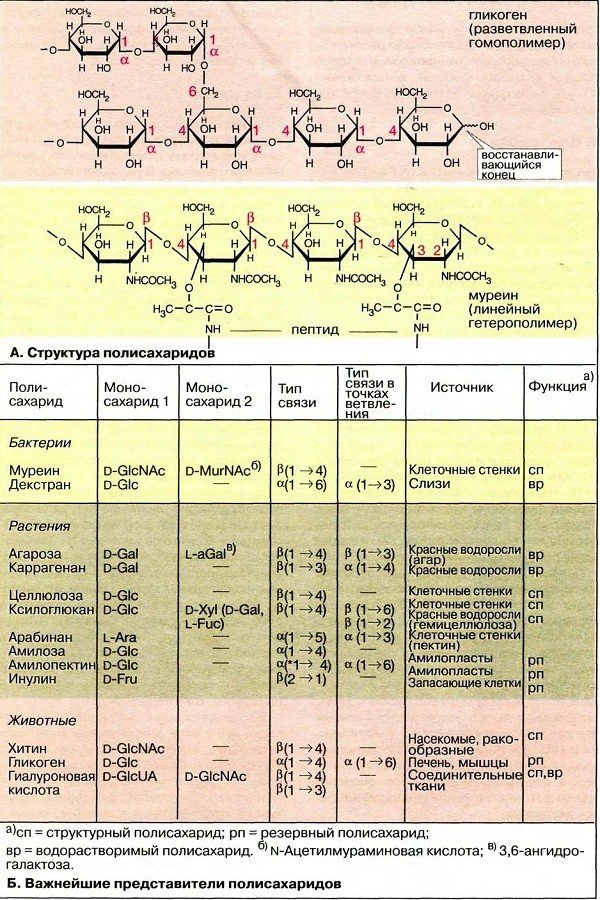
Many microorganisms easily degrade starch to glucose, but most are unable to digest cellulose or other polysaccharides such as chitin. These carbohydrates can only be digested by certain bacteria and protists. Ruminants and termites, for example, use microorganisms to digest cellulose.
Even though these complex carbohydrates are not very easily digestible, they are important for nutrition. They are called dietary fiber because they improve digestion and promote better intestinal motility. The main function of dietary fiber is to promote the absorption of other nutrients.
Polysaccharides differ in the composition of monomers, the length and degree of branching of the chains. They can have a linear unbranched (cellulose, chitin), branched (glycogen) and mixed structure (starch is a mixture of polysaccharides - approximately 80% (by weight) it consists of branched amylopectin and 20% linear polysaccharide amylose).
In functional terms, polysaccharides are distinguished for reserve, structural and protective purposes. Typical reserve polysaccharides are starch and glycogen. Structural polysaccharides include cellulose (fiber). The protective function in animals is provided by heparin and hyaluronic acid.
Starch and glycogen
Starch and glycogen store metabolic energy.
Starch (C6H10O5)n is a polymer whose monomer is α-glucose. It consists of a mixture of other polysaccharides - amylose and amylopectin. Amylose has the form of a long chain linked into a spiral; it is this configuration that provides the blue color of soluble starch when iodine is added. Amylopectin is a tree-like branched chain; it turns brown in the presence of iodine. Starch is the main reserve carbohydrate of plants, which is one of the products of photosynthesis. It accumulates in the chloroplasts of leaves, seeds, tubers, rhizomes, bulbs, and is deposited in cells in the form of starch grains in special organelles - amyloplasts. Starch content:
- in rice grains - up to 86%;
- wheat - up to 75%;
- in potato tubers - up to 25%.

Starch is the main carbohydrate in human food; it is broken down by the enzyme amylase. Starch grains are practically insoluble in water, but amylose swells when it is heated, while amylopectin does not change even with very long boiling.

Glycogen (C6H10O5)n is a polysaccharide consisting of 30,000 α-glucose residues. Its chains are more branched than those of starch. Its branching pattern is similar to the starch component amylopectin, which is why it is often called animal starch. It does not give a blue color when in contact with iodine. Glycogen is a storage carbohydrate in animals. It accumulates in the liver (up to 20%) and in the muscles (4%), in small quantities it is found in the kidneys, brain cells and blood leukocytes. Most often used as a source of glucose to replenish its reserves in the blood. There is glycogen in the cells of fungi, including yeast. Unlike starch, glycogen is soluble at room temperature.
Cellulose
Cellulose is a polymer in which the monomer glucose is linked together using the β type. This is the main structural polysaccharide of the plant cell wall; it accumulates about 50% of the total carbon in the biosphere. The cellulose content in wood is up to 50%, in cotton seed fibers - up to 98%.
Cellulose molecules do not branch, but are assembled into very strong fibers from parallel-laid chains bound into bundles by hydrogen compounds. They are insoluble in water, externally similar to the part of starch - amylose, with one difference - cellulose chains connected by the β type are not broken down in most living organisms, since they lack the enzyme cellulase necessary for this. Because cellulose cannot be broken down in the digestive tract of animals, it can act as a biological structural material. But some ruminants, such as cows, are helped to digest cellulose by symbiotic microorganisms.
Cellulose is food not only for cows, but also for fungi, microorganisms, some protists and animals (termites). Microorganisms capable of breaking down cellulose are also part of the microflora of the human large intestine.
Chitin
Chitin (French chitine, from ancient Greek χιτών: chiton - clothing, skin, shell) is a structural polysaccharide found in the cuticle of arthropods and a number of other invertebrates (worms, coelenterates), the cell membranes of some fungi and protists. In addition to carbon, hydrogen and oxygen, its molecules contain nitrogen (C8H13NO5)n, this is how it differs from cellulose. It consists of N-acetylglucosamine residues linked together by β-glycosidic bonds. Few organisms, such as some bacteria, are capable of assimilating chitin. But many creatures produce the enzyme chitinase, probably as a defense against mold.
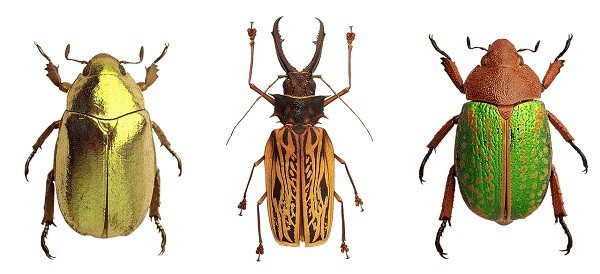
Functions of carbohydrates in the human body
- The role of carbohydrates is great. Once in the gastrointestinal tract, they are broken down into glucose, which in turn enters the cells and is used by the body as a source of energy. When they are insufficient to produce energy, proteins and fats break down, which leads to the accumulation of toxic ketones in the blood.
- They are able to accumulate in the liver, skeletal muscles, and other tissues in the form of glycogen.
- They take part in the synthesis of many substances necessary for the normal functioning of your body. For example, complex proteins, components of the immune system, etc.
- Regulates the metabolism of proteins and fats.
- Necessary for the normal functioning of the heart, liver, muscles and central nervous system.
Complex carbohydrates
Carbohydrates with a low glycemic index (Complex carbohydrates are complex compounds consisting of many atoms. Since the human body can accumulate and consume exclusively glucose (a fairly simple carbohydrate), complex carbohydrates must undergo a preliminary breakdown process and this takes some time.
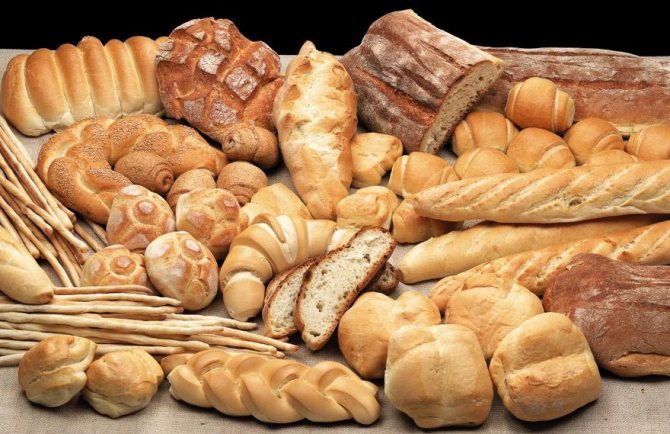
Complex carbohydrates Complex (or long-acting) carbohydrates form the basis of a marathon runner's diet.
Since the breakdown of complex carbohydrates (into glucose) occurs gradually and smoothly, excess sugar in the blood is eliminated; consuming complex carbohydrates in food allows you to accumulate enough glycogen. This is why complex carbohydrates form the basis of a marathon runner's diet.
Long carbohydrates include:
- pasta
- legumes
- cereals and porridges
- fruits, berries, vegetables and herbs
- …
For a complete list of complex and simple carbohydrates, see the end of the article.
What foods contain carbohydrates
Most foods are carbohydrates. They are not found in products of animal origin (meat, fish and seafood, eggs, etc.). The exception is dairy products that contain the milk sugar lactose.
Sources:
- Fruits.
- Vegetables, greens.
- Cereals, different types of flour.
- Nuts and seeds.
- Legumes (beans, peas, lentils, soybeans).
- Bread, pastries, cakes, pastries, etc.
- Pasta, noodles.
- Sugar, starch, honey.
- Carbonated drinks with sugar, compote, juices, tea and coffee with sugar.
- Alcohol.
- Dairy products, etc.
Products containing them
The list of foods that contain complex carbohydrates is extensive. Their peculiarity is a neutral taste, inherent in most dietary dishes and completely uncharacteristic of food with fast carbohydrates. These are cereals, vegetables and fruits with a low GI index.
List of foods rich in long-term carbohydrates:
- coarse wheat pasta;
- bran bread;
- unsweetened cookies;
- rice, buckwheat, pearl barley, corn porridge and oatmeal;
- peas and beans;
- asparagus;
- soy products;
- all types of nuts;
- dried apricots;
- peaches, apples;
- citrus;
- pears, cherries, avocados;
- spinach leaves;
- onions, tomatoes, nightshade;
- bell pepper;
- white cabbage, cauliflower and broccoli;
- parsley, dill, cilantro.
Eating complex carbohydrates allows you to replenish energy costs without the formation of fat deposits. In reasonable quantities, such food can be consumed throughout the day.
Grocery list
Simple carbohydrates
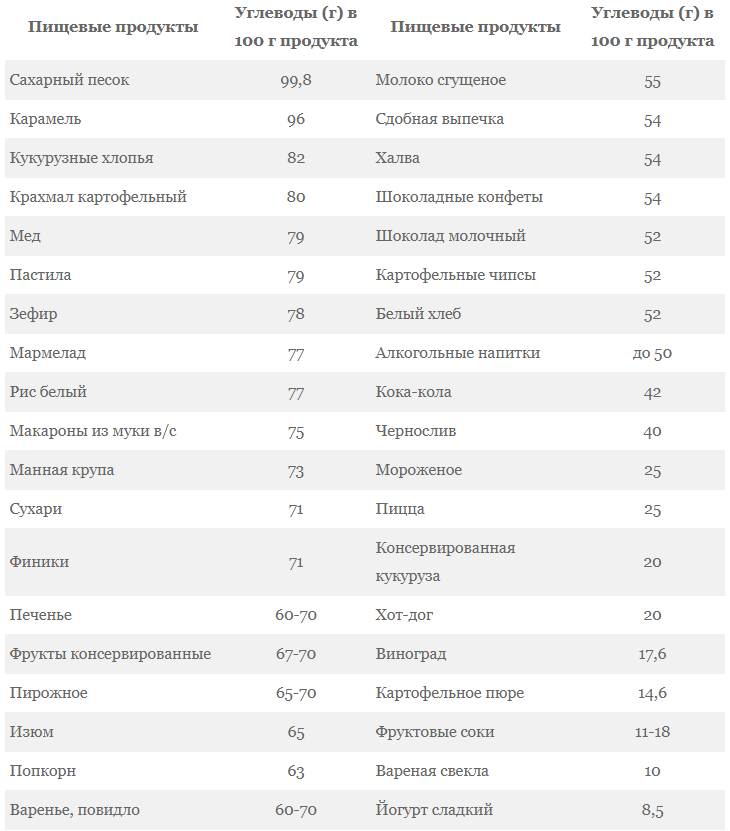
Complex carbohydrates
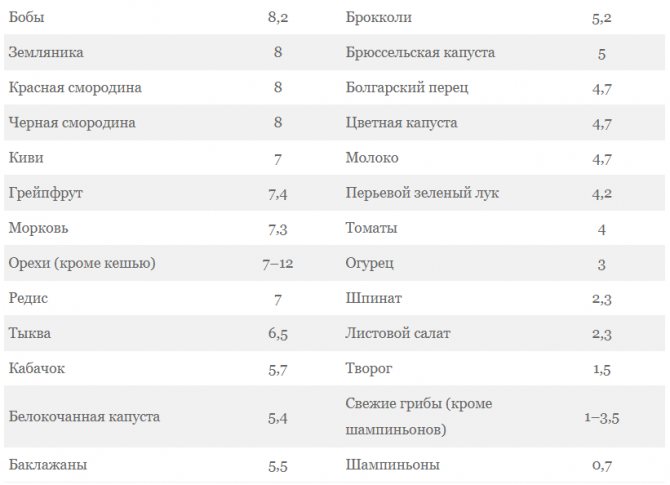
And now the results
To ensure that the effectiveness of your training is always at its best, and that you have a lot of strength and energy for this, it is important to adhere to certain rules:
- The diet should consist of 65-70% carbohydrates, and they should be “correct” with a low glycemic index;
- Before training you need to consume foods with average GI values, after training – with low GI values;
- Breakfast should be as dense as possible, and in the first half of the day you should eat most of the daily dose of carbohydrates;
- When buying products, check the glycemic index table and choose those that have medium and low GI values;
- If you want to eat foods with high GI values (honey, jam, sugar), it is better to do this in the morning;
- Include more cereals in your diet and consume them regularly;
- Remember, carbohydrates are assistants to proteins in the process of building muscle mass, so if there is no tangible result for a long time, then you need to reconsider your diet and the amount of carbohydrates consumed;
- Eat non-sweet fruits and fiber;
- Remember wholemeal bread and baked potatoes in their skins;
- Constantly update your knowledge about health and bodybuilding.
If you adhere to these simple rules, your energy will noticeably increase, and the effectiveness of your training will increase.
Daily carbohydrate needs
The daily intake will be different for each person.
On the Internet, some sites claim that the carbohydrate norm is 3–5 g per 1 kg of weight. In reality, everything is more complicated. The norm must be calculated for each person individually .
The need depends on gender, age, weight, activity level , etc. Also, your current goals are of great importance. For example, when losing weight and gaining muscle mass, you need completely different amounts of carbohydrates per day.
As an example, calculations were made for a 30-year-old man and woman of average height and low activity. See table below.
In the case of weight gain, average activity was taken (3 workouts per week).
Based on your gender, weight, and weight goals, you can determine your carbohydrate needs. Of course, the figure is approximate, but the error will not be very large.
| 50 -55 kg | 55-60 kg | 60-65 kg | 65-70 kg | 75-80 kg | 80-85 kg | |
| Men | ||||||
| Weight loss | 140 | 145 | 150 | 155 | 160 | 165 |
| Weight maintenance | 160 | 165 | 170 | 175 | 180 | 185 |
| Muscle gain | 270 | 280 | 290 | 300 | 315 | 325 |
| Women | ||||||
| Weight loss | 110 | 115 | 120 | 125 | 135 | 140 |
| Weight maintenance | 130 | 137 | 145 | 150 | 160 | 165 |
| Muscle gain | 228 | 240 | 245 | 255 | 270 | 280 |
When gaining muscle mass, the body needs a lot of energy. In this case, it is recommended to focus on foods high in carbohydrates. Of course, not forgetting about proteins and fats.
Lack of carbohydrates
A deficiency can cause weakness, fatigue, irritability, and apathy. In addition, muscle tissue and fat reserves, as well as proteins and fats supplied with food, will begin to be used as a source of energy.
Excess carbohydrates
Excessive amounts of them lead to a set of extra pounds .
Abuse of simple carbohydrates can lead to diabetes, arterial hypertension, insulin resistance, cardiovascular diseases and cancer.
Complex carbohydrates , on the contrary, can prevent these and other diseases . Fiber plays a big role here.
When the need increases
Since carbohydrates are the main source of energy, the need for them increases with increased mental and physical activity. If you decide to play sports, gain muscle mass, or your new job involves heavy physical activity, increase the amount of carbohydrate-containing foods.
Table of complex and simple carbohydrates
The glycemic index depends on many factors, and the easiest (for the average person) way to determine it is this table.
| Product | Index | Product | Index | Product | Index |
Long (slow or complex) carbohydrates | |||||
| Avocado | 10 | Cheese Tofu (soy) | 15 | Soybeans | 15 |
| Bran | 15 | Green salad | 15 | 15 | |
| Cabbage (fresh or pickled white cabbage, cauliflower, Brussels sprouts, broccoli, etc.) | 15 | Nuts (pistachios, pine nuts, hazelnuts, walnuts, peanuts, almonds, etc.) | 15 | Onions, leeks, asparagus | 15 |
| Bran | 15 | Olives | 15 | Sorrel | 15 |
| Black currant | 15 | Gherkins | 15 | Zucchini, zucchini | 15 |
| Bell pepper | 15 | Champignon mushrooms | 15 | Dark chocolate (>85%) | 20 |
| Cocoa powder | 20 | Eggplant | 20 | Nut butter | 25 |
| Blackberry | 25 | Gooseberry | 25 | Dry peas | 25 |
| Red currants | 25 | Raspberries | 25 | Strawberry | 25 |
| Cherry | 25 | Fresh pear | 30 | Fresh grapefruit | 30 |
| Tangerines | 30 | Cow's milk, soy milk | 30 | Raw carrots | 30 |
| Natural cottage cheese | 30 | Fresh apricot | 30 | Garlic | 30 |
| Pasta (vermicelli) from durum wheat | 35 | Red and black beans | 35 | Tomato juice | 35 |
| Dried apricots | 35 | Fresh peach or nectarine | 35 | Quince | 35 |
| Figs | 35 | Pomegranate | 35 | Beans | 35 |
| Fresh orange | 35 | Bread with seeds | 35 | Fresh green peas | 35 |
| Fresh or baked apple | 35 | Plum | 35 | Wild rice (black) | 35 |
What carbohydrates should you eat to lose weight?
If you want to lose weight and get rid of your belly fat, you first need to give up simple carbohydrates with a high glycemic index - sugar, sugary drinks, desserts, baked goods and white bread. As Fitseven mentioned above, the harm of regularly consuming such foods is not their high calorie content, but the fact that they disrupt metabolism and provoke a chronic feeling of hunger.
List of healthy carbohydrates:
Products that do not contain carbohydrates
Many effective diets for weight loss are based on giving up carbohydrates (complete or partial) - from a low-carbohydrate diet to a keto diet. In this case, not only processed grain products (bread, pastries, pasta), but also potatoes and all kinds of cereals are completely excluded from the diet. It is allowed to eat meat, eggs, green vegetables, as well as nuts and seeds in moderation.
As for products labeled “sugar-free,” they cannot always be considered dietary. In some cases, manufacturers use other sweet carbohydrates instead of sugar - for example, maltodextrin. Despite a different name and a more complex chemical formula, this substance has a high glycemic index - in fact, the body reacts to it in the same way as to regular sugar.
Carbohydrates in food: what do we know about them?
For the correct, healthy flow of metabolic processes in his body, a person must nourish it with proteins, fats and carbohydrates in a balanced form and quantity. In order to consciously manage these processes in your body, family members, taking into account the characteristics of age, gender, health status, lifestyle, goals, of course, you need to have certain information about how certain products behave in the process of their assimilation. This article is about carbohydrates.
Feelings from eating slow and fast types
The experience of eating slow and fast carbohydrates varies significantly. Try observing how you feel after eating foods rich in these compounds. If within half an hour you feel a surge of energy, then these were fast (simple) carbohydrates
It is important to understand that this sensation often passes with unpleasant consequences caused by a surge in insulin levels. If after eating you did not experience a sharp surge of energy, but the feeling of hunger does not return for a long time after such a meal, then you consumed slow carbohydrates
They allow you to provide the body with energy for a longer period, although the fast type of connections is sometimes useful for giving strength to the body in case of overload and the need for quick mobilization.

Products containing carbohydrates of animal origin
Many weight loss diets involve eating only protein foods; this approach gives results, but is not good for health. It is best to eat foods containing carbohydrates wisely, and to do this you need to know which carbohydrates are contained in which foods.

Having this information, having decided on the desired menu and creating for yourself, based on this information, an individual table of foods with carbohydrates, you can achieve excellent results in getting your figure in order without compromising your health, by eating a varied diet and without tormenting yourself with hunger.
